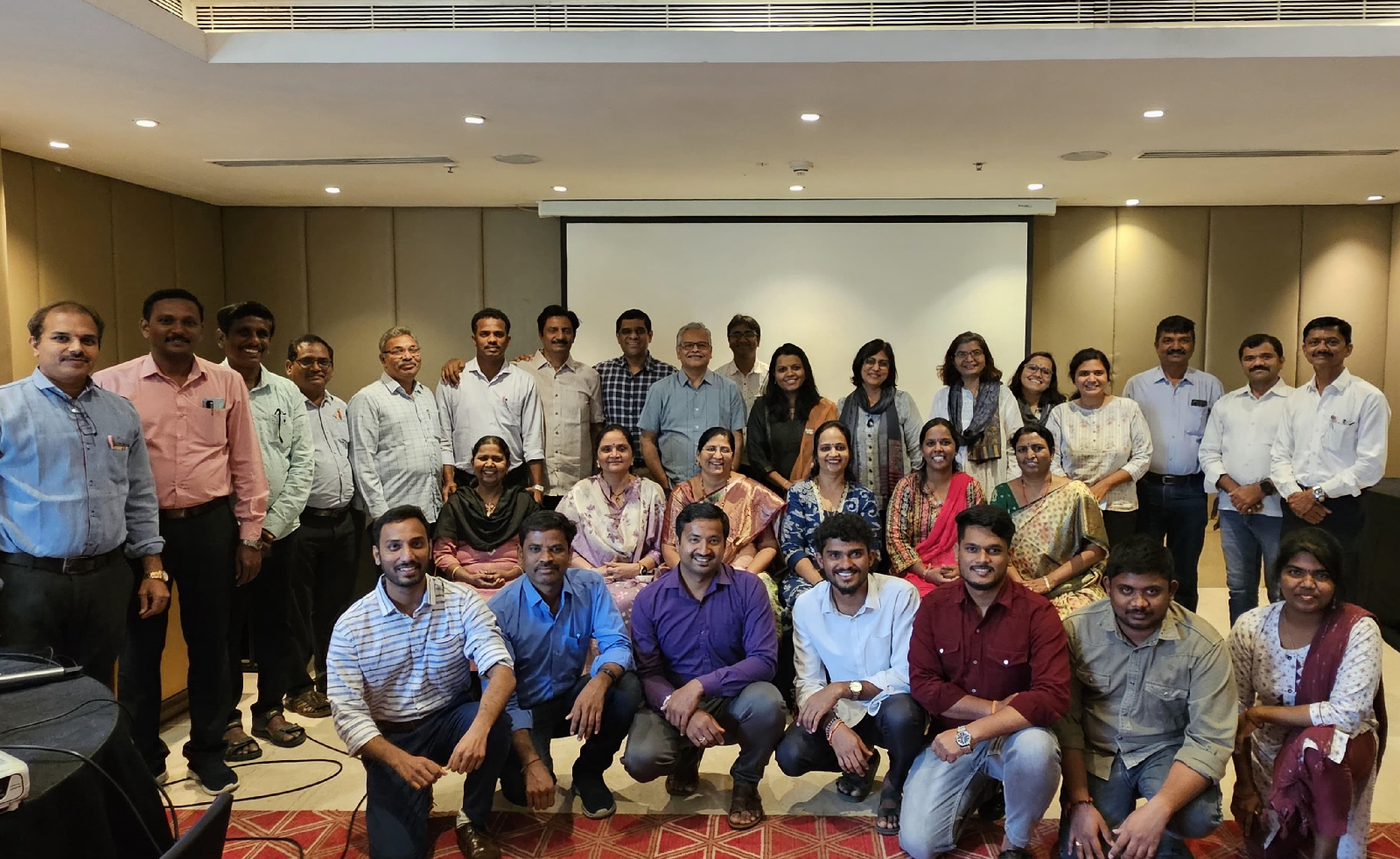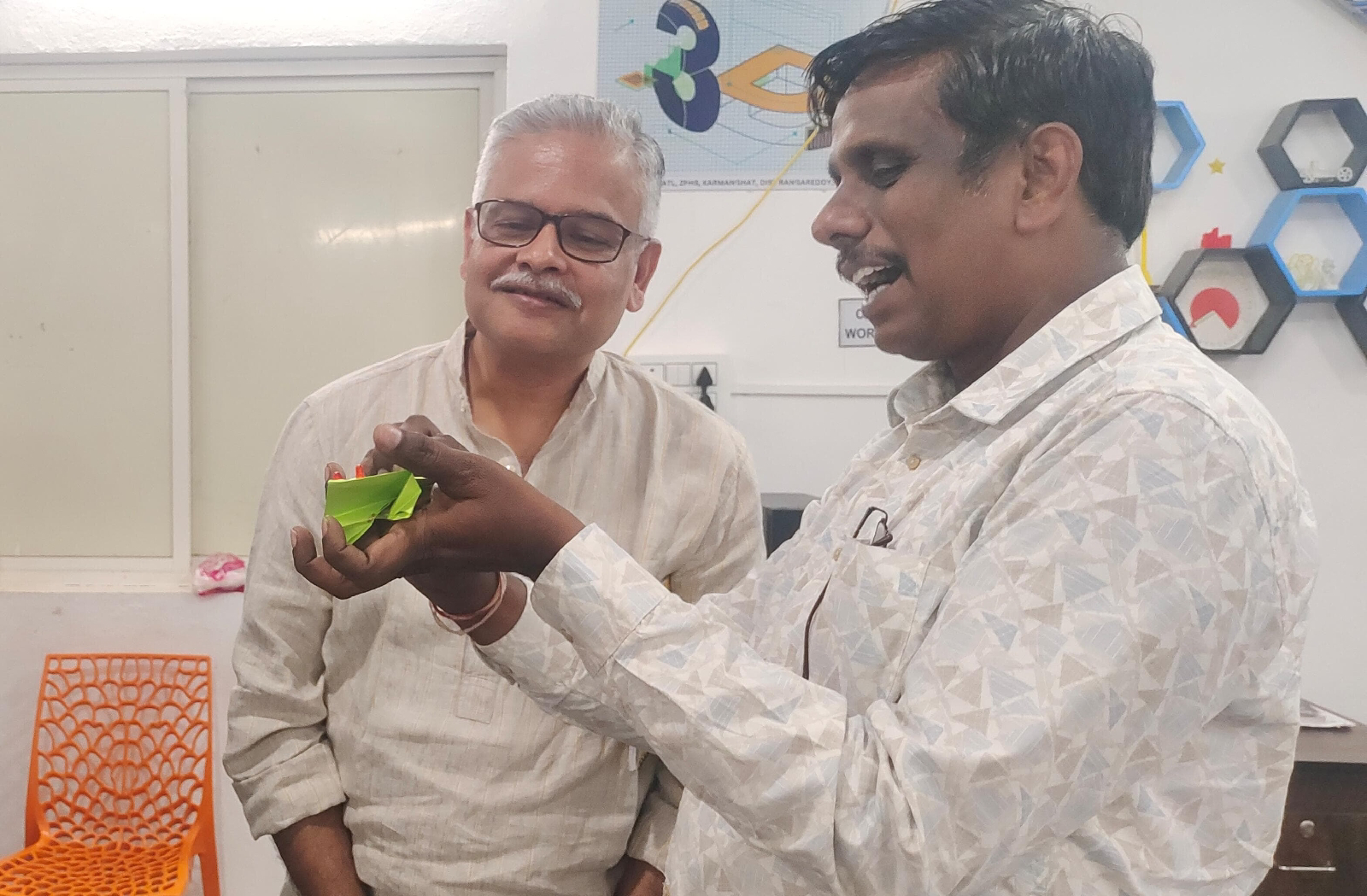Learning through constructivistic approaches
Learning through constructivistic approaches
Ramesh Vanapalli
In this article, I am addressing our work about 3d crop cultivation along with proper evidences. And also I would like to aware the future teachers and students about how to lead the projects and what steps they need to fallow and how to teach the basic science concepts through the projects.
Passion and efforts:
It's 2009 , I have promoted as a high school teacher for teaching physical sciences. I got this a great chance after completion of my 14 years teaching in primary school . Then I was very hopeful, energetic, enthusiast , optimistic and just 35 years old. I have started my journey in ZP high school L KOTA with lots of passion to create real scientific temper and atitude among the students. Started my teaching in practical and experimental approach. Students has been done several projects under my guidance. Project method of teaching and constructive approach is not a closed way of learning. It's open ended and not time bounded. So me and my students has missed several periods by doing projects in lab. But no one has shouting the students and me. Engage those periods smoothly. So I can't forget the cooperation, and support from the school head and colleagues . Then I found passive and constructive approaches of teaching are two different weapons . Never they can't fit in same case. So period patterns should be changed accordingly. In this sequence , me and my students work has received national level inspire award in 2011. That project was very worthy. Later I had taken up that project as realtime research. My work has published in AJABS journal in June 2015. I felt very happy to saw our work has been implementing recently in Kenya. Fig 2 crop cultivation in cone shape fields in Kenya
As per design of above 3D fields , there is no air flow pipes . So Here what I could found that there is no possibility of any hallow chamber in inside of the field. So above fields might miss the self life and self regulatory features. So here I am suggesting to those farmers in Kenya to modify their 3d field designs .
Story of our innovation
Motivational session:
In 2011 January students came after Pongal holidays. I made a discussion with 8 th class students about inspire awards has been announced by the department of science and technology, India.
I Gave an assignment to the students for list out the problem s occurred in their surroundings, and in the society.
After 3 days I had reviewed about problem statements. Students found several problems like expensive crop cultivation, garbage, plastic polution, air and water polution, bad drainage system, etc.
Problem statement
one group of students has selected expensive agriculture as their unique problem statement . They has started their project to reduce expenses in crop cultivation and to increase crop yields. I felt it's big task. Also I gave another task to the students that make an interview with 10 more farmers in their village to know briefly about the agriculture and main key problems in it.
Interview:
After few days students submitted their interview report and list out the main reason s for why agriculture made as expensive such as
a) Lack of regular water source
b) irregular rains and irregularities in seasons
c) High temperature s
d) Low yields
e) hiking of labour charges
f) Hiking of cost of artificial fertilizer and pests
g) Expensive cultivation operations like ploughing, leveling, seeding, weed management, cutting, Threshing etc
Then I appreciated the students work well and gave some inputs about Dr MS Swaminathan and his Green revolution in india.
Higher order thinking:
Thulasi from 7th class, A sravani from 8th and Gopi Krishna from 8th were taken up this project. Sravani asked a question that , Why the bananas brought by my father from forest area are very bigger than the normal which were grown in our plain area ? We are using artificial fertilizer s , pesticides and sufficient water. But on the hills , even there is no sufficient water source, no fertilizers and pesticides , crops growing well and products are very fresh and healthy. Why? What are the reasons? . Really it's a great observation and questioning by that kid. Then I was appreciate her questioning and said we need to do some more research on what reasons for crop growth and yield differences in between hill and plain regions.
Field Trip:
After few days, We have planned the field visit to the hill area Rega punyagiri which is near by our village. Total 15 students, four guides including me traveled 10 km by bus and 6 km by walk. It's a great experience to the students and teachers. Students enjoyed lot in the nature and knew many science concepts like biodiversity, medicinal plants, temperature differences , pressure differences, soil composition, deforestation, pollution, climate change it's bad impacts etc. We have reached that tribal village by 1pm . Students took an interview of villagers about their crop cultivation method s , fertilizer s , pesticides which they are using etc. students collect little bit of soil from those fields. After lunch we have returned back and reached homes safely. Co teachers care and efforts are truly appreciable.
I gave an assignment to the students to submit brief report on this field visit. Also I gave a clue for more understanding about how to write the field trip report. Students consolidated their views and observed things and wrote a report . There is a comparative study on different parameters like soil texture , soil health, atmospheric conditions, cultivational operations, yield and growth of the crops in hill and plain regions. Finally students concluded that coarse and sandy soil with natural fertile leafi material, cool and Low pressure, no need of ploughing, leveling, artificial fertilizer s and pesticides are the main reason for positive results of crop cultivation on hills.
Review of literature:
I have conducted brain storming session about analyse the positive parameters of crop cultivation in hill area. Then I given some questions to the students for get more understanding about crop cultivation such as
a) why the low temperatures and pressure s recorded on the hills?
b) why the atmospheric conditions in plain area are very horrible?
c) can we reduce temperature s artificially in crop fields in plain area ?
d) what is the optimum temperature required to huge plant growth?
e) why the farmers plough the fields ?
f) How the course and sandy soil helps the plant growth?
g) what is reason for fields in hill area are maintaining continuous moisture?
h) can we maintain continuous moisture in the crop fields in plain area by using less water?
I) which fertilizer s and pesticides using by the farmers? Why?
j) Are there any sustainable practices in using fertilizer s and pesticides?
K) Are there any alternative feasible methods to increase yield of the crops? etc
Students searched the answers for above mentioned questions in Google search and made few discussions farmers and teachers. Then proposed some solutions.
Hypotheses:
a) coarse, sandy and fertile soil enable to keep moisture continuously, increase oxygen availability at the roots, roots can spread easily, fertile and leaf material provides required nutrients. So we need to make the soil like coarse sandy and fertile.
b) Regular evaporation and condensation processes in the fields can reduce temperature s and keep moisture in the fields. If Air moves from high volume to low volume or leanior gaps then speed of the air increases, inturn creates Low pressure and cool the surroundings. So if we make the field in cone or pyramid shape, the air will enter from the bottom and moves up ward, gets cool and passes through the soil and water vapour condense itself. This process can be continued regularly. So we need to convert two dimensional fields in to three dimensional cone and pyramid shape fields.
c) cone base area pi r2 . But surface area is 2 pi rl
It's more than double than base area. Hills appearing in cone shape . So these can create more surface area and gives more yield. So 3 D fields can double the crop yield.
d ) capillary fibre material can lift the water from ground to top of the field.
e) ploughing , leveling weed management of the fields make the soil healthy and provides the sufficient oxygen to the roots and provides nutrients to the plants.
3d field s also do same and No need of ploughing and weed management. So expenses can be reduced.
Conceptualization:
Students learnt several basic science concepts like soil properties, nutrients required for the plants , different types of fertilizer s , plant respiration, growth, yield etc
Also learnt about cooling technologies, evaporation, condensation, joule Thompson effect, Charles law, Boyles law , Endothermic and exothermic reactions and capillarity etc
And from the maths, students aware about 2 dimensional and 3 dimensional shapes, volumes, base and surface area s of different shapes etc.
Designing and Experimentation:
Students form the 2d field and 3d fields in equal base area 4ftx4ft at the team leader sravani 's house. Seed the leaf vegetable seeds. Provide all requirements like water, fertilizer etc eaqually for both fields. Made comparative study on field temperatures 3 times per day , plant growth etc this study has taken up during 24/4/2011 to 12/5/2011 (18 days) . Positive results were found. This project has got first prize in National level inspire exhibition held in August 2011 at Delhi. Again two times We took the data from the same fields for cross checking the data. Same results repeated.
Results:
Rising of 3d field temperature at morning when comparing with 2d field and atmosphere indicates condensation of water vapour taken place in the field.
Decreasing 3d field temperature at noon when comparing with 2d field and atmosphere indicates that the evaporation taken in the field.
In this way 3d field maintaining constant optimum temperature all-over the day. So double the yield and growth of the crop could possible.
Conclusion:
Creating knowledge about the nature is more effective approach of learning than the acquiring knowledge about the nature. Project method of teaching and learning is effective approach rather than the other methods like demonstration and experimental approaches. Students can know the laws and principles and verify them through experiments but students can't apply their knowledge in particular problematic situations. So such knowledge meant for keep in our memory and recall it . Applicable knowledge is productive and called knowledge of commodity. Above our work developed by using few basic science laws and principles. Students could knew how to apply the laws and principles at right time. Done research, data mining and data analysis. Many concepts could learnt by the students through out the process. So I hope that all the students should get such meaning full learning opportunities. Also I hope that the young farmers should aware about the 3d crop cultivation methods and they should bring it in to the real time implementation.
Ramesh Vanapalli
Mentor and ATL incharge







Comments
Post a Comment